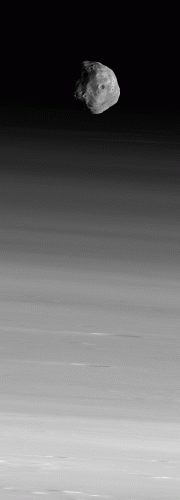For a long time, scientists thought the Martian moons, Deimos and Phobos, were captured asteroids. Now, however, many are examining the idea that the moons formed in orbit around Mars, accreting from debris in the aftermath of a big impact. (In addition to any yet-unidentified impact basins, Mars offers several large and suitably ancient ones, such as Borealis, Elysium, or Daedalia.)

HURTLING MOON. Much scarred by impacts, Phobos hangs over Mars in a view taken by the Mars Express spacecraft. About 22 kilometers in diameter, Phobos is the inner (and larger) of Mars’ two moons. It orbits so close to Mars that it circles the planet more than three times each day. A new study suggests that Phobos and Deimos probably formed comparatively far from Mars, within a disk of debris thrown into space by a giant impact. (ESA/DLR/FU Berlin [G. Neukum
Writing in Icarus, Pascal Rosenblatt (Royal Observatory of Belgium) and Sébastien Charnoz (Université Paris Diderot) explore the dynamics of making Phobos and Deimos from a disk of debris in Martian orbit. As a first approach, they chose two cases to study, “the strong-tide regime for which accretion occurs close to the planet at the Roche limit, and the weak-tide regime for which accretion occurs farther from the planet.”
For Mars, the Roche limit is the distance (about 2.5 Mars radii) where tidal forces are stronger than a moon’s self-gravity. At or inside the Roche limit, a moon will either break apart — or in the case of a debris disk, never make a moon in the first place. Currently Phobos orbits at 2.8 radii and Deimos at 6.9. At 6 radii (between these two orbits) lies synchronous orbit — where a moon makes one circuit of Mars per Martian day.
The scientists found that in the strong-tide, or near-Mars version, “moonlets can form close to the planet by gravitational instabilities…. The shape and density of Phobos and Deimos are consistent with those expected for these moonlets.”
But there’s a big snag. In the calculations they discovered that “all Martian moonlets orbit Mars below synchronous orbit, so they recede back to Mars in less than 200 million years.” Yet both moons are considerably older than that, judging by the size and number of craters on their surfaces.
So turning to the weak-tide scenario, the researchers write that it “allows for the accretion of a Deimos-mass moonlet (as an embryo resulting from a runaway growth from smaller planetesimals) near the current distance of Deimos.” In addition, they write, “a Phobos-mass moonlet can also be formed but closer to Mars (3 to 4 Mars radii), due to its larger mass than that of Deimos.”
But again the orbital lifetime problem arises. “However, at such distances to Mars, this accreted body is expected to fall back rapidly onto Mars due to the tidal decay of its orbit, and so not to survive over billions of years in Mars orbit.”
That result doesn’t look good for either moon. However, nature offers a possible solution. The team explains, “In the weak-tide regime, embryos can accrete together to form a reduced population of larger bodies. In that case…because of tidal effects, we may expect that embryos below synchronous orbit may migrate inward and form larger objects — and embryos beyond synchronous limit may migrate outward while growing bigger.”
“Does such a process end in one single Phobos below synchronous orbit and one single Deimos beyond synchronous orbit?” the researchers ask. “The present study does not answer that question, but it emphasizes that there is clearly a mechanism of accretion that must be investigated in the case of the formation of the Martian moons.”








